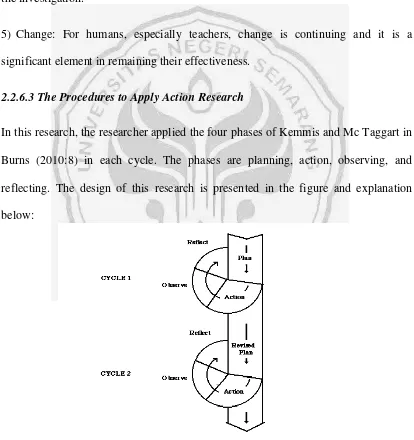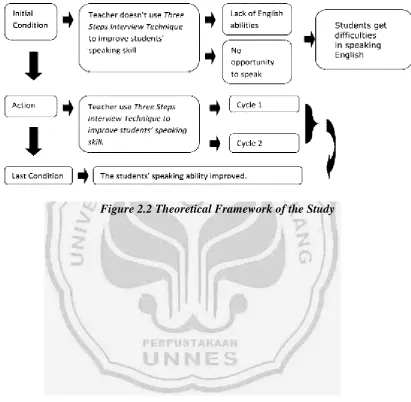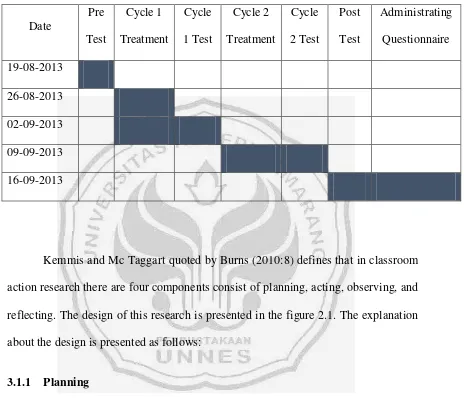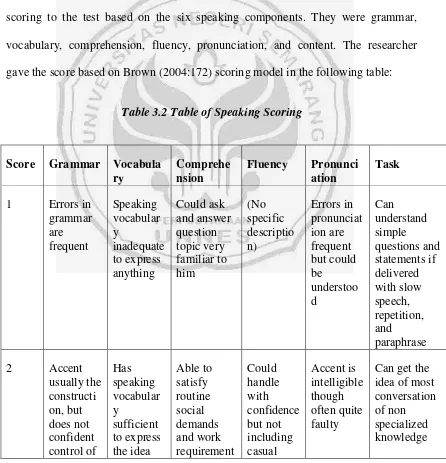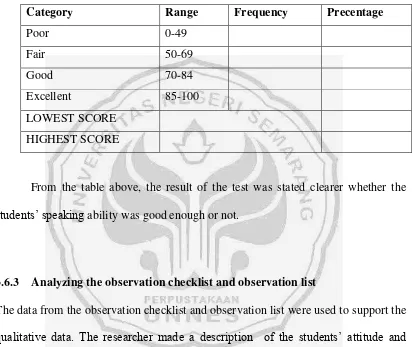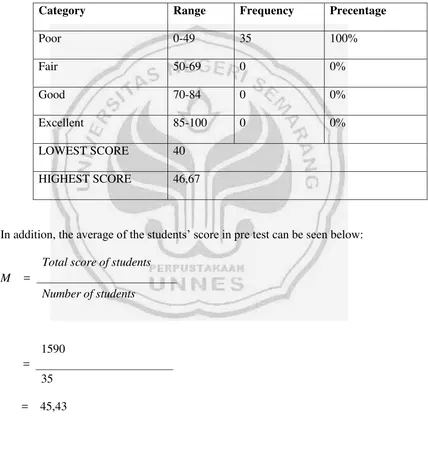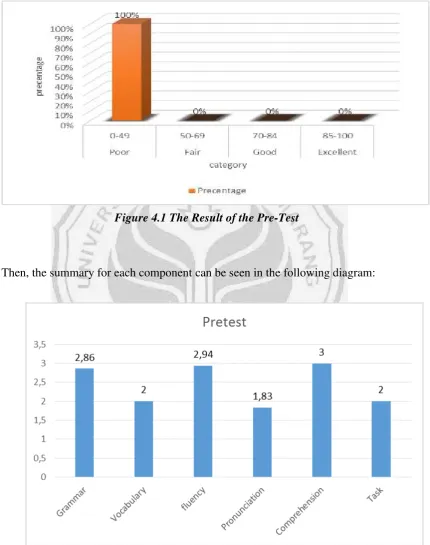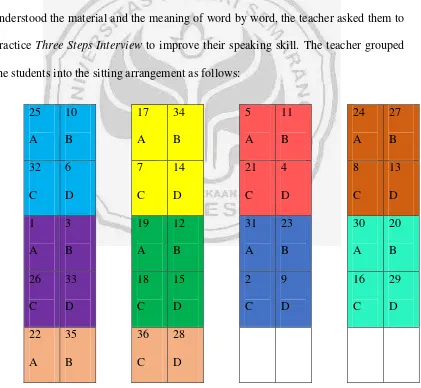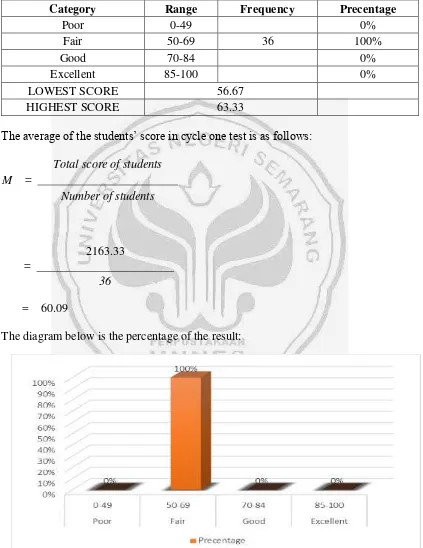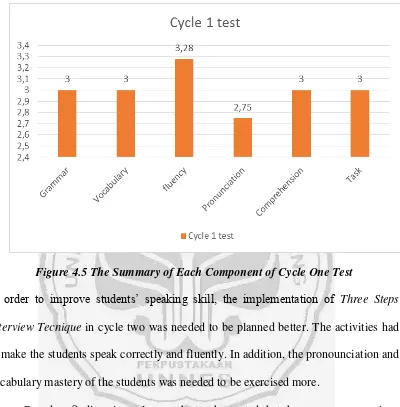THROUGH THREE STEPS INTERVIEW TECHNIQUE
(An Action Research of the Tenth Grade Students of SMK Negeri 9 Semarangin the Academic Year of 2013/2014)
a final project
submitted in partial of the requirement for the degree of Sarjana Pendidikan in English
by:
Rani Candrakirana Permanasari 2201409060
ENGLISH DEPARTMENT
FACULTY OF LANGUAGES AND ARTS
SEMARANG STATE UNIVERSITY
iii
NIM : 2201409060
jurusan/prodi : Bahasa dan Sastra Inggris/Pendidikan Bahasa Inggris fakultas : Bahasa dan Seni
menyatakan dengan sesungguhnya bahwa skripsi / tugas akhir / final project yang berjudul:
“Improving Students’ Speaking Skill Through Three Steps Interview
Technique. (An Action Research of the Tenth Grade Students of SMK Negeri 9 Semarang in the Academic Year of 2013-2014).”
yang saya tulis dalam rangka memenuhi salah satu syarat untuk memenuhi gelar sarjana pendidikan bahasa inggris ini benar-benar merupakan karya saya. Semua kutipan baik yang langsung maupun tidak langsung, atau yang diperoleh dari sumber lainnya, telah disertai keterangan mengenai identitas sumbernya dengan cara sebagaimana yang lazim dalam penulisan karya ilmiah. Dengan demikian, walaupun tim penguji dan pembimbing penulisan skripsi/tugas akhir/final project ini membubuhkan tanda tangan sebagai tanda keabsahannya, seluruh karya ilmiah ini tetap menjadi tanggung jawab saya sendiri. Jika kemudian terdapat pelanggaran terhadap pelanggaran konvensi penulisan ilmah, saya bersedia menerima akibatnya dan mengadakan perbaikan. Demikian, pernyataan ini dibuat dengan sebenarnya.
Semarang, 5 Februari 2014
iv
(QS: Az-Zumar 39:10)
DEDICATION:
v
project so I could learn a lot about patience and humility.
I sincerely grateful to Sri Wahyuni,S.Pd., M.Pd., as my first advisor for her patience in giving me guidance, brilliant ideas and help to finish the final project. I would like to extend my sincere thanks to Rini Susanti Wulandari, S.S., M.Hum., as my second advisor for her time in giving me a guidance to improve my final project for its perfection. Not to mention, I would like give my deepest thank to Drs. Alim Sukrisno, M.A., my first examiner for his kindness, advices, and appreciation to my final project.
My appreciation is also dedicated to all lecturers of the English Department of Semarang State University who have given worthwhile knowledge and experiences since
I was in the first semester.
Next, my gratitude goes to the headmaster of SMK N 9 Semarang for allowing me to carry out the investigation in that school. I also thank to Sukarni, S.Pd., for giving the contribution while I was conducting the research there, and all of the students of X.AK1 for their cooperation while I did my research.
My deep thanks go to my beloved father, mother, my aunt, and my two sisters
for their support, great love, patience, and pray. I also thank to my three lovely little
nephews who made me smile when I was down. A great thank is also dedicated to
vi
vii
Department. Faculty of Languages and Arts. Semarang State University. First Advisor: Sri Wahyuni, S.Pd., M.Pd., Second Advisor: Rini Susanti Wulandari, S.S., M.Hum.
Key Words: speaking, cooperative learning, three steps interview technique, action research.
The tenth grade students in vocational schools are expected to be able to speak the simple utterances in English. However, in reality, only a few students in vocational school could do that. Based on that condition, this study is aimed knowing how Three Steps Interview Technique improve the students’ speaking skill. The subject of this study was 36 students of class X AK.1 in SMK N 9 Semarang.
The research method used was an action research. This study conducted five meetings for two cycles. The first cycle was conducted in two meetings and the second cyle was conducted in one meeting. One meeting was for pre-test and the last meeting was for post-test. The intruments used in this study were speaking tests, observation check list, an observation list, and a questionnaire.
The result of the study showed that the students’ responses in learning speaking was good. They enjoyed the activities using Three Steps Interview Technique in class by having a discussion, sharing, and cooperating well. The students’ improvement was proved by their speaking test results which increased from test to test. In pretest, all of students final scores were under 50. In the cycle one test, no one of them got final score less than 50. From the cycle two test, most of the students got final score more than 70. Then, the data of post-test showed that all of the students got score more than 70.
viii
……….
TABLE OF CONTENTS ………..viii
LIST OF TABLES...xii
LIST OF FIGURES...xiii
LIST OF APPENDICES ………...xiv
CHAPTER I INTRODUCTION ………...………...1
1.1 Background of the Study………...………1
1.2 Reasons for Choosing the Topic………...……...4
1.3 Research Problem...………...…..5
1.4 Purpose of the Study... ………...5
1.5 Significance for the Study………….………....5
1.6 Outline of the Report………...6
II REVIEW OF RELATED LITERATURE…………...………...8
2.1 Review of the Previous Studies………....……….8
2.2 Review of the Theoritical Study……….………...10
2.2.1 Language Skill………...10
2.2.2 Speaking Skill………...11
2.2.3 Teaching English Speaking...13
2.2.4 Cooperative Learning...………….………...16
ix
2.2.4.5 The Structures of Cooperative Learning ...19
2.2.4.6 Learner and Teacher Roles...20
2.2.5 Three Steps Interview Techniques... 22
2.2.5.1 General Concept of Three Steps Interview Technique... 22
2.2.5.2 The Aims of Three Steps Interview Technique...23
2.2.5.3 The Benefits of Three Steps Interview Technique...23
2.2.5.4 The Procedure of Three Steps Interview Technique...23
2.2.6 Action Research ...24
2.2.6.1 The Definition of Action Research... 24
2.2.6.2 The Basic Principles of Action Research...25
2.2.6.3 The Procedures of Action Research...26
2.2.6.4 The Benefits of Action Research...27
2.3 Theoritical Framework ………...29
III RESEARCH METHODOLOGY ………..……...31
3.1 Research Design ………...31
3.1.1 Planning ………....32
3.1.2 Acting ………...33
3.1.3 Observing...34
3.1.4 Reflecting...34
x
3.6 Procedure of Analyzing the Data………...…...39
3.6.1 Transcribing the Students’ Speaking Test………...40
3.6.2 Scoring the Students’ Productions...………...40
3.6.3 Analyzing the Observation Checklist and Observation List...42
3.6.4 Analyzing the Questinnaire...42
IV FINDINGS AND DISCUSSION...43
4.1 Data Analysis...44
4.1.1 Analysis of Pre Test...,...44
4.1.2 Analysis of Cycle One...59
4.1.3 Analysiz of Cycle One Test ...53
4.1.4 Cycle Two...57
4.1.5 Cycle Two Test...58
4.1.6 Post Test...62
4.2 Analysis of Questionnaire...67
4.3 Analysis of Observation Checklist and Observation List ...70
4.3.1 Analysis of Observation Checklist and Observation List in Pre-Test ...71
4.3.2 Analysis of Observation Checklist and Observation List in Cycle One Process ...72
xi
4.4.2 The Advantadges of Using Three Steps Interview Technique in
Teaching Speaking...82
V CONCLUSION AND SUGGESTION...84
5.1 Conclusions ………..……..84
5.2 Suggestions...85
BIBLIOGRAPHY...87
xii
3.2 Speaking Scoring...40
3.3 Score Classification...43
4.1 The Summary of Pre-test Result...47
4.2 The Summary of Cycle One Test Result...55
4.3 The Summary of Cycle Two Test Result...60
4.4 The Summary of Post-test Result...63
xiii
2.2 Theoretical Framework...30
4.1 The Result of the Pre-test...48
4.2 The Summary of Each Component of Pre-test...48
4.3 The Students’ Sitting Arrangement...50
4.4 The Result of the Cycle One Test...55
4.5 The Summary of Each Component of Cycle One Test...56
4.6 The Result of the Cycle Two Test...61
4.7 The Summary of Each Component of Cycle Two Test...61
4.8 The Result of the Post-test...64
4.9 The Summary of Each Component of Post-test...64
4.10 The Improvement of All Students’ Test Result in Each Component...66
xiv
3. Lesson Plan 1...94
4. Lesson Plan 2...97
5. Lesson Plan 3...98
6. Lesson Plan 4...108
7. Learning Material for Cycle 1...112
8. Learning Material fo Cycle 2...116
9. Pre-test Instrument...118
10. Cycle One Test Instrument...119
11. Cycle Two Test Instrument...120
12. Post-test Instrument...121
13. Students’ Pre-test Transcription...122
14. Students’ Cycle One Test Transcriptiont...126
15. Students’ Cycle Two Test Transcription...133
16. Students’ Post-test Transcription...138
17. Students’ Pre-test Result...145
18. Students’ Cycle One Test Result...147
19. Students’ Cycle Two Test Result...149
20. Students’ Post-test Result...151
21. Students’ Test Result Summary...153
xv
26. Observation Checklist 4...162
27. Observation List 1...164
28. Observation List 2...166
29. Observation List 3...168
30. Observation List 4...170
31. Questionnaire...171
32. Questionnaire Result...173
1
This chapter presents the introduction of the research, which is divided into six sub chapters: general background of the study, reasons for choosing the topic, statement of the research problem, purpose of the study, significance of the study, and outline of the study report.
1.1 General Background of the Study
Indonesian students in a school have to learn English as one of the target languages. They need to learn both language skills and also language components. Language skills as stated by Brown (2001:232) are listening, reading, speaking, and writing. Language components contain vocabulary, grammar, and pronunciation. Furthermore, students are expected to be able to apply those skills and components in their daily activities.
Related to the information above, one of the important skills that should be learned by the students is speaking skill. Lado in Flutcher (2003:18) wrote :”The ability to speak a foreign language is without doubt the most highly prized language skills and rightly so.” In other words, he wants to say that speaking is the most
accustomed themselves to speak in English will find many difficulties when they learn to speak in English.
In a vocational school, the English material tends to be English practice, like a communicative English, that will be useful for the students when they participate in some vocations . Based on the School Based Curriculum (KTSP), the levels of study in vocational school are divided into three; they are novice, elementary, and intermediate level (Sudira, 2006:51). Students in the tenth grade of vocational schools are expected to get to the novice level. Based on American Council on the Teaching of Foreign Language, ACTFL Guidelines 1986, “Novice level is characterized by an ability to communicate minimally with learned material” (Flucher, 2003:230). It means the students in grade ten of vocational school at least could understand and answer the question in target language in the simple utterances (Sudira, 2006:51).
Second, the teacher does not create the appropriate conditions in class where the students can actively communicate with others in English. It can be caused by the situation that there is no adequate resources including teaching materials and also teaching media. The lack of resources also impacts the teacher’s knowledge about teaching and learning method in which the students have more opportunities to explore themselves. The teacher still uses the traditional method where he or she becomes the center of the class.
In relation to the statements in the previous, the researcher intends to help the English teacher improves the students’ speaking skill by introducing one of cooperative learning techniques. Brown (2001:47) states “in cooperative classroom the students and the teachers work together to pursue goals and objectives.” It means
in a cooperative classroom the interaction between students and teachers in teaching and learning process will be created. The researcher will offer a cooperative learning technique named Three Steps Interview that may become the most appropriate alternative solution to solve the problem. Kagan stated that by using Three Steps Interview Technique, Each person much produce and receive language during the process of learning. The students have their own roles and turns to practice speaking in English (Jacob, et all :1997).
In short, Three Steps Interview Technique may be very useful to help teacher to improve students’ speaking skill because students will have an interaction in pairs
1.2 Reasons for Choosing the Topic
Based on the general background above, the researcher intends to give an alternative teaching techniques that can be used in teaching speaking to the students and make speaking class enjoyable, interesting and communicative. The reasons why the researcher chooses the topic “Improving students’ speaking skill through Three Steps Interview Technique” are as follows :
First, speaking is one of the important skills that should be learned by the students. Students of vocational schools will meet some situations in their vocations when they need to communicate using English. Therefore, by having a good ability in speaking, they can communicate better.
Second, the students have difficulties in speaking English because they are not accustomed themselves to speak in English. Thus, the students should be given more opportunities to share their idea by using English orally.
Third, many teachers still use a conventional method like classroom lecturing to teach English and it is boring. The teacher needs to be introduced to another method to teach English which is more interesting. Based on that reason, the researcher think that the cooperative learning technique can be the most appropriate solution to solve the problems.
have their own turn. The technique will make them not only active in thinking but also in speaking. It also helps the teacher to teach the students speaking English easier and more interesting. Students will not be bored because they have to be active and give their participation.
1.3
Research Problem
Based on the topic chosen and the general background stated above, the research problem are :
1) To what extent does Three Steps Interview Technique improve students’s speaking skill?
2) How do the students respond the technique?
1.4
Purpose of the Study
The purpose of the study is to find out in what aspects Three Steps Interview Technique improves students’ speaking skill. The study also tries to find out the students’ responses to the technique.
1.5
Significance of the Study
Theoretically, the study will provide teachers with a new understanding about the use of Three Steps Interview Technique to improve students’ speaking skill.
motivation to learn what to speak and how to speak in English through group work, so the learners can support each other. This technique will make speaking process, especially for delivering an idea easier. For the English teachers, they will have an alternative technique to help them improve their students’ speaking skill. They can manage their students effectively in class by doing Three Steps Interview Technique. For other researchers, they can have an alternative source when they intend to do another research about the same technique or skill. They can develop other ideas based on this research.
Pedagogically, the result will give the readers fundamental knowledge that can be implemented in the classroom for the benefit of the students’ development in
speaking English.
1.6
Outline of the Study Report
This final project report is divided into five chapters. Each chapter will be explained as follows:
Chapter I presents introduction that consists of general background of the study, reasons for choosing the topic, research problem, purpose of the study, significances of study, and outline of the study report.
Chapter III presents research methodology. This chapter deals with research design, subject of the study, instruments for collecting the data, procedures of collecting the data, procedures of analyzing the data, and criterion of assessment.
Chapter IV presents the data anaylisis and the discussion of the findings. This chapter discusses the result of the study in detail by using supporting evidence that the reseacher gets from the research.
8
CHAPTER II
REVIEW OF RELATED LITERATURE
This chapter presents the review of related literature, which is divided into three sub chapters: review of the previous studies, review of the theoretical studies, and theoretical framework
2.1
Review of the Previous Studies
Many researchers have done the studies about how to improve students’ speaking
skill. Some of them also choose Cooperative Learning and working in groups as the teaching method. The followings are some of them:
Moreover, the students exposed to the cooperative instructional method were reported significantly more favorable attitudes toward classroom instruction.
The research about Cooperative Learning is closely related with the research about working in groups. McCafferty et all (2006:39) also mentioned that group work was the main requirement to achieve cooperative learning goal. Thus, the studies above have a relationship with the study in Semarang State University done by Suriya (2011). Her research was about using Think Pair Square Share as one of Cooperative Learning techniques, in teaching speaking for students of vocational school. She found that by using the Cooperative Learning technique, the students’ speaking ability improved. By applying Cooperative Learning, students showed positive responds, they were motivated to learn English because the technique made English was easier to be learnt.
Another research was conducted by Itsnaini (2011). Her research was about the use of Round Robin technique to improve students’ speaking skill. Round Robin is also one of Cooperative Learning techniques. The result of the research showed that Round Robin technique was useful in teaching learning process to improve students’ speaking skill. It helped students very much to learn speaking optimally.
whether Three Steps Interview Technique may be used as an alternative teaching technique to improve students’ speaking skill. Because by using cooperative learning
method in teaching and learning activities, students will do many activities in group that will help them achieve the goals of learning English.
2.2
Review of the Theoretical Studies
The researcher carries out some underlying studies as guidance. This sub chapter shows the review of some theoretical studies based on many experts. The review is divided into 6 parts; they are language skills, speaking skill, teaching English speaking, Cooperative Learning, Three Steps Interview Technique, and action research.
2.2.1 Language Skill
In this part, the researcher presents about the theoretical studies of language, skill, and language skills.
Based on Oxford Dictionary, “skill is an ability to do something expertly or
well.” In addition, the definition of skill in Wikipedia is “the learned ability to carry
out a task with pre-determined results often within a given amount of time, energy, or both.” Therefore, language skill is an ability to use an arbitrary system of speech
sounds to communicate ideas, feelings, and desires that can be learnt by practicing.
Based on the use of language, Brown (2001:232) and Benner (2002:43), mentioned language skills consisting of reading, writing, listening and speaking. All those skills are important to be learnt because they related one to another. Students in vocational schools have the same responsibilities to learn about all those skills. They will apply them when they involve in the work place. Not to mention, in the globalization area English skills will be very useful to support their job career.
Futhermore, Heaton (1974:12) states, “one of skills that is important in daily
life is speaking ability since the area of language are firstly presented orally before reading and writing are practiced.” In other words, speaking is the basic language skill that should be learnt by the students. For that reason, the researcher concerns herself only in speaking skills.
2.2.2 Speaking Skill
According to Flutcher (2003:23), “speaking is the verbal use of language to
communicate with others” Moreover, Mackey in Bygate (1987:5) summarized speaking, the oral expression, as follows: “Oral expression involves not only the use of the right sounds in the right patterns of rhythm and intonation, but also the choice of words and inflections in the right order to convey the right meaning.”
In other words, Burns and Joyce in Florez (1999:1) defined “speaking is an interactive process of constructing meaning that involves producing, receiving, and processing information.” Yet, Brown (2001:267) stated that “the successful of language acquisition is almost always the demonstration of an ability to accomplish pragmatic goals through interactive discourse with other speakers of the language.” When people speak, they do not only think about the use of right sounds or patterns but also the choice of words in order to communicate with other persons so they can convey the right meaning.
Brown (2004:141) cites five stages of speaking performance. They are imitative, intensive, responsive, interactive, and entensive. The explanation about those categories is stated as follows:
1) Imitative: the ability to simply imitate a word or phrase or possibly a sentence. In this stage, the teacher focuses only on students’ pronunciation than the ability to
understand or convey meaning.
be able to respond, but interaction with an interlocutor or test administrator is minimal as best.
3) Responsive: this performance includes interaction and test comprehension, but at the somewhat limited level of very short conversation, standard greetings, small talk, simple request, and comments.
4) Interactive: in this stage, the length and complexity of the conversation is more then responsive stage, which sometimes includes multiple exchange and/or multiple participants.
5) Extensive: extensive oral production includes speeches, oral presentations, and story telling. In this stage, the students should be able to produce their own language with their own idea.
A teacher should know that speaking is not only about the use of the right sounds but also the choice of words so that someone can communicate with others. The stage of students’ performance also becomes part of consideration to design English teaching activities. The goals of our teaching will influence the activities in the class.
2.2.3 Teaching English Speaking
pay attention to. In this part, the researcher present the information about teaching English speaking.
Teaching speaking gives a systematic information, instruction, or training to students about how to convey meaning to communicate with other by using correct sounds and words. In line with that statement, Nunan in Thomas (2011:18) describes what teaching involves. He stated to teach speaking means to teach language learners to:
(1) “produce the English speech sounds and sound patterns;
(2) use word and sentence stress, intonation patterns and the rhythm of the second language;
(3) select appropriate words and sentences according to the proper social setting, audience, situation and subject matter;
(4) organize their thoughts in a meaningful and logical sequence; (5) use language as a means of expressing values and judgments; and
(6) use the language quickly and confidently with few unnatural pauses, which is called as fluency.”
students in vocational school includes in teenagers. Teenager is an age of transition, confusion, self-consiousness, growing, and changing body and minds (Brown, 2001:92). He also mentioned how to keep students’ self-esteem because it will be most important corcern to teach teens. They are “avoiding embarrassment of students at all costs, affirming each person’s talents and strengths, allowing mistakes and other errors to be accepted, de-emphasizing competiton between classmates, and encouraging small-group works.
After the teacher knows how to handle teens students, Brown (2001:275) mentioned seven principles for designing speaking techniques. They are: “(1) using techniques that cover the spectrum of learner needs, (2) providing intrinsically motivating techniques, (3) encouraging the use of authentic language in meaningful contexts, (4) providing appropriate feedback and correction, (5) capitalizing on the natural link between speaking and listening, (6) giving students opportunities to initiate oral communication, and (7) encouraging the development of speaking strategies.”
Another idea is from Johnson in Setiyadi (2006:19). They suggested five possible learner roles that can make language learners more autonomous. One of them is “learners are member of a group and learn by interacting with others”. It
means that by working in groups, students will have more opportunity to speak up their idea in order to learn English more effective.
ability by considering some factors such as students ages, teaching materials, and teaching method. A good strategy will influence the success of the goal achievement.
2.2.4 Cooperative Learning
In this part, the researcher presents the information related to Cooperative Learning. They are definitions, basic principles, aims, advantages, structures, and the last is teacher and learner’s roles.
2.2.4.1 Definition of Cooperative learning
First defintion comes from Richards and Rodgers (2001:195). They described “Cooperative Language Learning is an approach designed to foster cooperation rather than competition, to develop critical thinking skills, and to develop communicative competence through socially structured interaction activities.”
Another statement came from Macpherson (2011), she defines “cooperative learning is part of a group of teaching or learning techniques where students interact with each other to acquire and practise the elements of a subject matter and to meet common learning goals. It is much more than just putting students into groups and hoping for the best.”
students are motivated in cooperative learning to help one another master skills or learn the material.”
In addition, Kagan (1994) defined “cooperative learning is a successful teaching strategy in which small teams, each with students of different levels of ability, use a variety of learning activities to improve their understanding of a subject.” Based on definitions stated above, we can get several points that should be apply in cooperative learning. They are small group, group working, social interaction, work together, and help each other.
2.2.4.2 Basic Principles of Cooperative Learning
Kagan in Richards and Rodgers (2001:196) proposed five basic principles of cooperative learning as follows :
1) Positive interdependence
Group members feel that what helps one member helps all and what hurts one member will hurts all. Learners in group help, assist, encourage, and support each others’ efforts to learn. Students must feel that they need each other in order to complete the group's task, that is, they "sink or swim together.”
2) Group formation
3) Individual accountability
The individual accountability involves both groups and individuals performance. The performance of each individual learner is assessed and the results are given back to the group and the individual. Ways to build in individual accountability include: students take individual quizzes; each student is responsible for a specific portion of a task; each must be able to summarize another's ideas; any student may be called on at random to answer for the team.
4) Social skills
Skill communication is necessary for effective group functioning so that the students can interact each other with their reammates. These include skills for working together effectively (staying on task, summarizing, recording ideas) as well as group maintenance skills (encouraging each other). Learners must have, and use, the needed leadership, decision making, trust-building, effective communication, and conflict-management skills.
5) Structuring and structures
“It refers to the ways of organizing the students’ group. The ways includes how the
students interact with the teammates.”
2.2.4.3 The Aims of Cooperative Learning
The application of cooperative learning method in teaching and learning has goals based on Richards and Rodgers (2001:193) as follows:
1) “to provide opportunities for naturalistic second language acquisition through the use of interactive pair and group activities,
2) to provide teachers with methodology to enable them to achieve this goal and one that can be applied in variety of curriculum settings,
4) to provide opportunities for learners to develop successful learning and communication strategies, and
5) to enhance learners motivation and reduce learner stress and to create a positive affective classroom climate.”
2.2.4.4 The Advantages of Cooperative Learning
McGroarty in Richards and Rodgers (2001:195) offers six learning advantages by doing Cooperative Learning in classroom activity. They are:
1) “increased frequency and variety of second language practice through different types of interaction,
2) possibility for development or use language in ways that support cognitive development and increased language skills,
3) opportunities to integrate language with content-based instruction,
4) opportunities to include a greater variety of cirrcular materials to stimulate language as well as concept learning,
5) freedom for teachers to master new proffesionals skills, particularly those emphasizing communication, and
6) opportunities for students to act as resources for each other, thus assuming a more active role in their learning.”
2.2.4.5 Structures of Cooperative Learning
learning process depending on the student’s ability, condition and levels. According to Kagan (1994), there are number of Cooperative Learning structures and techniques categorized as follows:
(1) Team Building
This category focuses on doing brainstorming in teaching activities. This category has three structures, RoundRobin , Corners, and Match.
(2) Mastery
This category concern in how students could master the lesson. This activity also has three structures, Numbered Heads Together, Color-Coded Co-op Cards, and Pairs Check.
(3) Concept Development
In this category, students are supposed to gain their knowledge from the lesson. They are expected to develop their concept of the lesson in solving the problem. It includes three structures, Three-Step Interview, and Think-Pair-Share.
(4) Multifunctional
This category could be applied in any situation of the teaching learning process. It could be used for manage the classroom, understanding the lesson, and developing the lesson. It includes five structures, RoundRobin , Inside-Outside Circle, Partners, Jigsaw, and Co-op Co-op.
2.2.4.6 Learner and Teacher Roles
are also directors of their own learning. They are taught to plan, monitor, and evaluate their own learning (Richards and Rodgers, 2003:199).
The teacher role in cooperative learning is different from the teacher role in traditional teaching method. In cooperative learning, Johnson et all (1994) mentioned that the teacher has to create a highly structured and well-organized learning environment in the classroom; set goals, plan, and structure tasks; establish the physical arrangement of the classroom; assign students to groups and roles; and select materials and time. An important role of the teacher is being the facilitator for the students.
Harrel in Richards and Rodgers (2001:199) added “as a facilitator, the teacher gives feedback, redirects the groups with questions, encourages the groups to solve the problems, extends activities, encourages thinking, manages conflict, observes students, and supplies resources.”
accustomed themselves to respect their partner, be dicipline, and be more responsible with their own.
2.2.5 Three Steps Interview Technique
The previous part has given the information about Cooperative Learning. The researcher chooses one of the Cooperative Learning technique as a suggestion for teachers to improve students’ speaking skill. It is Three Steps Interview technique. In this part, the researcher presents the information related to Three Steps Interview technique. There are general concept, aims, benefits, and the procedures.
2.2.5.1 General Concept of Three Steps Interview Technique
Lipton and Wellman (1998) defined Three Step Interview Technique is a cooperative structure that helps students personalize their learning. It also teach them to listen to and appreciate others’ thinking and idea. Being active in listening and paraphrasing will develop the students’ understanding and empathy to other person.
Three Steps Interview Technique is an effective way to encourage students to share their thinking, ask questions, and take notes. It works best with four students per group, but it can be modified based on class situations.
2.2.5.2 The Aims of Three Steps Interview Technique
The aims of Three Steps Interview technique is to engage students in conversation for the purpose of analyzing and synthesizing new information. Three-Step Interview is a strategy that is effective when students are solving problems that have no specific right answers. Three problem-solving steps are involved in this process (Kagan, 1994).
2.2.5.3The Benefits of Three Steps Interview Techniques
Three Steps Interview technique will give benefits to the students as follows: 1) Three-Step Interview creates simultaneous accountability,
2) students share and apply different questioning strategies, and
3) over time, students can be introduced to different taxonomies of thinking to extend their ability to use different levels of questioning and thinking.
2.2.5.4The Procedure of Three Steps Interview Technique
Based on Olsen and Kagan in Richards and Rodgers (2001:198) , the procedure of Three Steps Interview technique are as follows:
1) teacher makes a group of 4 students and gives them labelled. It can be A, B,C, D, 2) teacher pairs the student A with student B, and student C with student D,
3) teacher gives topic to the studnets,
5) student A interview student B. Student C interview student D, 6) students reverse roles, and
7) each shares with team member what was learned during the two interviews. Three Steps Interview technique is one of Cooperative Learning in which students works in a group consisting of 4 persons. Students will be accuctomed to have a conversation for the purpose of analyzing and synthesizing new information by listening to and appreciating the others’ idea and thinking. Three Steps Interview technique will also help students speak in English, because they have to make an interaction with their partner in order to share the ideas orally. So, Three Steps Interview Technique is very useful to be used by the teacher to improve students’
speaking skill.
2.2.6 Action Research
In this part, the researcher will show the information related to Action Research. They are definitions of action research, basic principles of action research, the procedure to apply action research, and the benefits of action research.
2.2.6.1 The Definition of Action Research
Also disscussing about action research, Carr and Kemmis in Burns (2003:30) argued that classroom action research is “simply a form of self-reflective enquiry undertaken by participants in social situations in order to improve the rationality and justice of their own practices, their understanding of these practices and the situations in which the practices are carried out”.
Another statement mentioned by Wallace in Suriya (2011), “an action research is a process, which is done by systematically collecting data on teacher’s everyday practice and analyzing it in order to come to some decisions about what her future practice should be.”
In short, action research is one of research designs that is commonly used by teacher that has function to improve students’ ability by applying some strategies in daily activities of teaching and learning proccess including daily practices and also evaluation.
2.2.6.2The Basic Principles of Action Research
A good teacher must consider some of the following principles to do an action research in order to achieve goals successfully. Borgia and Schuler in Hien (2009) described components of action research as follows:
1) Commitment: Time commitment should be carefully considered by participants of action research since it takes them time to get acquaintance with other participants, think about change, try new approach, collect data, interpret results, etc.
3) Concern: In the research process, participants will build up a group of “critical friends” who trust each other and the value of the project.
4) Consideration: As it is mentioned above, reflective practice is a mindful review of a professional research like action research. It demands concentration and careful consideration as one seeks patterns and relationships that will create meaning within the investigation.
5) Change: For humans, especially teachers, change is continuing and it is a significant element in remaining their effectiveness.
2.2.6.3The Procedures to Apply Action Research
[image:41.595.112.526.268.708.2]In this research, the researcher applied the four phases of Kemmis and Mc Taggart in Burns (2010:8) in each cycle. The phases are planning, action, observing, and reflecting. The design of this research is presented in the figure and explanation below:
1) Planning
The first phase in doing classroom action research is planning. In this phase, the researcher will identify a problem or issue and develop a plan of action in order to bring about improvements related with the topic. It includes problem and situation analysis and also prepare the instrument to collect the data.
2) Acting
Doing an action is the main phase of action research. In this step, the Three Steps Interview Technique will be the main activities to be applied. This phase is the implementation of the plan that the researcher has made to solve the problems. 3) Observing
This phase involves the researcher’s observation to the students’ activities during
teaching and learning process. This phase includes monitoring and evaluating the action. The researcher will observe systematically the effects of the action phase and documentating all the information about what is happening. The results of the observation will be used as the indicator to know the students’ progress of speaking
skill in each cycle. 4) Reflecting
A reflection is an effect to inspect what has been done. The result of reflection is used to establish the next steps of the research. In other words, a reflection is the inspection effort of the success or the failure in reaching the research purpose.
2.2.6.4The Benefits of Action Research
1) Teachers investigate their own practice in new ways, looking deeper in what they and their studenst actually do and fail to do.
2) Teachers develop a deeper understanding of students, the teacher learning process and their role in the education of both teachers and students.
3) Teachers are viewed as equal partners in deciding what works best and what needs improvement in their classroom or classrooms.
4) In most cases, solutions for identified problems are arrived cooperatively among teachers.
5) Teachers are often more committed to action research because they identify the areas they view as problematical and in need of change.
6) Action research is an ongoing process and its strategies can be widely applied. 7) Professional development and school improvement are core aspects for any teacher who engages in action research.
8) Teacher’s reflection can be conducted individually or in a school-based team composed of students, teachers and admistrators.
Sharing the view with Borgia and Schuler (1996), Mills (2006) in Hien (2009) admitted the importance of action research in education by adding that action research:
1) encourages change in schools,
2) fosters a democratic approach to education,
4) positions teachers and other eduactors as learners who seek to narrow the gap between practice and their vision education,
5) encourages educators to reflect on their practice, and 6) promotes a process of testing new ideas
2.3
Theoretical Framework
One of the important skills that should be learned by the students is speaking skill. In vocational school, the English material tends to English practice such as the communicative English that will be useful to the students when they engage in their vocations.
Many problems then arise when the students try to speak. Two of them are lack of English ability and no opportunity given by the the teacher. Those two reasons make the students can not speaking English in a good way. The researcher suggests the technique named Three Steps Interview Technique, which is one of the Cooperative Learning method, that may solve the problems. The process of the treatment will be conducted in two cycles. By doing the two cycles, the students’s
How the process of the research will be applied, the figure below presents the theoretical framework of the study:
31
CHAPTER III
RESEARCH METHODOLOGY
This chapter discusses the methods of investigation. There are seven subchapters: Research Design, Subject of the Study, Types of Data, Instrument of the Study, Procedure of Collecting Data, and Procedures of Analyzing Data.
3.1
Research Design
The researcher applied the classroom action research and took a part as a teacher for 36 students of X-AK1. The research was conducted in two cycles as an effort to improve the students’ speaking skills. The two cycles were called as cycle 1 and
cycle 2. It was conducted in five meetings starting from August 19th 2013 up to
September 16th 2013.
The first meeting was for pre-test in which the researcher tried to find out the students’ speaking skill before they got treatment. The second meeting was for cycle
The schedule of the research can be seen in the table as follows:
Table 3.1 Schedule of The Research
Kemmis and Mc Taggart quoted by Burns (2010:8) defines that in classroom action research there are four components consist of planning, acting, observing, and reflecting. The design of this research is presented in the figure 2.1. The explanation about the design is presented as follows:
3.1.1 Planning
The first phase was planning. This phase included problem and situation analysis and also preparationof the instrument to collect data.
The activities were:
(1) plan the implementation of doing three steps interview technique to teach speaking,
Date
Pre Test
Cycle 1 Treatment
Cycle 1 Test
Cycle 2 Treatment
Cycle 2 Test
Post Test
Administrating Questionnaire 19-08-2013
(2) make the instructional documents based on the syllabus of the 10th grade of the vocational school,
(3) arrange the activities guidelines to do three steps interview techniques in English learning process,
(4) arrange the evaluation program, and
(5) prepare the instruments to collect the data needed in this research.
3.1.2 Acting
In this step, Three Steps Interview techniques was applied. This phase was the implementation of the plan that the researcher had made to solve the problems. The action was done by the following steps as follows:
(1) teacher explained the materials,
(2) teacher explained about the three steps interview techniques, (3) students did the three interview techniques as follows:
1. the students made a group consists of 4 persons; 2. each person be labelled as A, B, C, and D; 3. teacher gave the topic to the students;
4. students were in pairs, one was the interviewer and the other was the interviewee.
5. student A interviewed student B. Student C interviewed student D; 6. students reversed roles; and
3.1.3 Observing
The teacher observed the students’ activities during teaching and learning process.
This step included monitoring and evaluating the action. The researcher used observation check list, observation list, and also questionnaire to observe the implemetation on Three Steps Interview Technique. The results of the observation were used as the indicator to assess the students’ progress of speaking skill in each cycle. The activities in this phase were:
(1) observing the activities as the implementation of three steps interview technique in teaching and learning process,
(2) taking note and taking some documentations, (3) evaluating student’s result after each cycle, and (4) asking students to answer the questionnaire.
3.1.4 Reflecting
In this phase, the researcher analyzed the result of the the test and observation. The analysis was used to determine the next strategy in the next cycle. In the cycle one of the research, the reflection was done after the researcher analyzed the data from observation checklist, observation list, and also the test result along the cycle one process. The results in cylce one were used to decide the next strategy in cycle two.
3.2
Subject of the Study
The subject of the study was tenth grade students of SMKN 9 Semarang in the academic year of 2013/2014. From five classes of all students in grade ten, X.AK.1 was chosen as the subject of the study. This class was chosen because it was the most managable class of all. There were 36 students in the class who got the treatment during the process.
3.3
Types of Study
This study used the qualitative and quantitative data. The qualitative data were gained from the observation, questionnaire, and the documentations. As stated by Anne Burns (2003:24):
The major focus of action research is on concrete and practical issues of immediate concern to particular social groups or communities. It is conducted in naturally occuring settings, primarily using methods common to qualitative research such as observing and recording events and behaviours.
The quantitative data were taken from the result of pretest, cycle 1 test, cycle 2 test, and post test that was used to prove the description. The results of all test were exactly used to support the qualitative data in describing the students’ achievement in
3.4
Instrument of the study
In this study, the researcher used three kinds of instrument to collect the data. There were test, observation list, and questionnaire which were explained as follows : 1) Test
Based on Airasian and Russel (2008:9) test is a formal, systematic, procedure used to gather information about students’ achievement or other cognitive skill. Test was used to measure the students’ achievement and students’ improvement during the
process.
In collecting the data the researcher used some kinds of tests. They were pre-test, post-pre-test, cycle test. Pre-test was given in the begining of the research to know their ability in speaking English before they got treatment. The cycle test was conducted after each cycle treatment. The aims of this test was to know the students’
improvement after each cycle treatment. The post-test was the last test to know the students’ improvement. The result of this post-test was compared with the others tests to find out the result of the students’ achievement data. During the process, the researcher assessed the students’ tests by using Brown Scoring system in table 3.2. 2) Observation list and observation checklist
the students’ presence, the students’ attention to the teacher, the students’
cooperation, the students’ self confidence, and the students’ understanding.
Then, the observation checklist (see appendix 23 page 156) was used to find out whether students are working in a groups in a correct way or not. A checklist was a written list of students’ performances in class to be observed. There were attending the class, paying attention to the teacher, following teacher’s instruction, working on
own, sharing information, listening to other waiting turn to speak, answering teacher question, interacting with the teacher, and doing the task well.
3) Questionnaire
Questionnaire, based on Airasian (2008:81), is a checklist to get responses or information from some people about factual or demographic, behavioural, and also attitudinal. From the questionnaire, the researcher collected the information from the students related to the implementation Three Steps Interview Technique to improve their speaking skill (see appendix 31 page 171). The questionnaire accomodated the students’ feedback and opinion about their interest in classroom activities, their
motivation in learning English by using three steps interview technique, the advantages of the three steps interview technique to improve their speaking skill.
3.5
Procedure of collecting the data
The procedure of collecting the data of the research is presented as follows: 1) Testing
asked to Each student was asked to introduce him/herself in front of the class. The introduction included name, age, address, when and where they were born (see appendix 9 on page 118).
The cycle test was conducted after each cycle treatment. The cycle test was conducted in two times, there were cycle one test and cycle two test. The aims of this test was to know the students’ improvement after each cycle treatment. The cycle one test was conducted ofter cycle one treatment. In this session, the students were asked to make a dialogue based on the situation given (see appendix 10 on page 119). They could choose one of the three situations freely. The dialogue was the implementation of the expression they had learnt such as greeting, introduction, thanking, and leave taking.
The next test was cycle two test. It was conducted after cycle two treatment. In this session, the students were asked to develop the short paragraph based on the interview of their friend (see appendix 11 page 120) and then shared their paragraph in front of the class orally.
The last test was post-test. It was conducted to know the students’ improvement. In this session, the students were asked to make a short paragraph about their house (see appendix 12 page 121) then shared it in front of the class orally. The result of all tests were compared to define the students’s achivement and
2) Observing
The researcher observed the students’ responses and also improvement by using observation list and checklist. Based on the criteria in the observation checklist, the resracher gave check (v) when the students did the criteria. The result from the observation checklist were summarized into observation list and describe based on the criteria in the observation list.
3) Using questionnaire
The researcher collected the information about students’ responses in the
implementation of Three Steps Interview Technique by using questionnaire in last meeting after doing the post-test. The students were asked to answer 15 questions (see appendix 31 page 171) related to their response and also their opinion about the treatment. The questions were Yes/No question, so the stduents can directly choose the answer based on their experiences during the process.
4) Taking documentation
The documentation was taken to support the data which obtained by taking photographs and recording the activities. The documentation of the research to be analyzed included the voice recording from the students.
3.6
Procedure of analyzing data
3.6.1 Transcribing the Students’ Speaking Test
The first step in analyzing the data was to transcribe the students’ speaking test such as pre-test, cycle tests, and post-test. The spoken data were transcribed verbatim, it meant the transcription includes silence and some strange voices produced by the speaker.
3.6.2 Scoring the Students’ Productions
[image:55.595.107.553.296.759.2]The next step that the researcher did after transcribing the students’ speaking test was scoring to the test based on the six speaking components. They were grammar, vocabulary, comprehension, fluency, pronunciation, and content. The researcher gave the score based on Brown (2004:172) scoring model in the following table:
Table 3.2 Table of Speaking Scoring
Score Grammar Vocabula ry
Comprehe nsion
Fluency Pronunci ation
Task
1 Errors in grammar are frequent Speaking vocabular y inadequate to express anything Could ask and answer question topic very familiar to him (No specific descriptio n) Errors in pronunciat ion are frequent but could be understoo d Can understand simple questions and statements if delivered with slow speech, repetition, and paraphrase
2 Accent
usually the constructi on, but does not confident control of Has speaking vocabular y sufficient to express the idea Able to satisfy routine social demands and work requirement Could handle with confidence but not including casual Accent is intelligible though often quite faulty
the grammar
s conservati
ons
3 Control of grammar is good and able to speak with sufficient structural accuracy
Vocabular y is broad enough that rarely has to grope for a world Could participate effectively in most formal and informal conversatio ns Could discuss particular interest of competenc e with reasonable words Errors never interfere with understand ing Comprehensi on is quite complete at a normal rate of speech
4 Errors in grammar are quite rare and able to speak accurately Could understand and participate in any conversati on. Could handle informal interpreting from and into language Could participate in any conversati on within the range of the experience with a high degree of fluency Errors in pronunciat ion are quite rare Can understand any conversation with the range of his experience
5 Equivalent to that of an educated native speaker Speech on all levels is fully accepted by educated native speakers Speaking proficiency equivalent to that of educated native speaker Has complete fluency in the language. Equivalent to and fully accepted by aducated native speaker Equivalent to that of an educated native speaker
The final score of the each student’s test calculated by the formula :
Final score =
Score X 10
Then, the final score of each student was clasified based on the table below:
Table 3.3 Table of Score Clasification
From the table above, the result of the test was stated clearer whether the students’ speaking ability was good enough or not.
3.6.3 Analyzing the observation checklist and observation list
The data from the observation checklist and observation list were used to support the qualitative data. The researcher made a description of the students’ attitude and
achievement in speaking after applying Three Steps Interview Technique.
3.6.4 Analyzing the questionnaire
The questionnaire was analyzed to find out the students’ interest in classroom
activities, their motivation in learning English by using Three Steps Interview Technique, the advantages of the Three Steps Interview Technique to improve their speaking skill. The questionnaire consisted of 15 questions. The students had to
Category Range Frequency Precentage
Poor 0-49
Fair 50-69
Good 70-84
Excellent 85-100
44
CHAPTER IV
DATA ANALYSIS AND DISCUSSION OF FINDINGS
This chapter presents the result of the study and its discussion. In this chapter, the data which had been collected were analyzed and interpreted. Therefore, it provides data
analysis of each activity including pre test, cycle 1, cycle 2, and post test. Moreover, this
chapter also presents the analysis of questionnaire, observation list and checklist, the
improvement of students’ speaking skill, and the advantages of Three Steps Interview
Technique. They are presented as follows:
4.1 Data Analysis
In this sub chapter, the researcher presents about the data analysis that was found during the implementation of the classroom action research in SMK N 9 Semarang. The primary data are pretest, cycle one test, cycle two test, and post test. The secondary data are observation checklist, observation list, and questionnaire. All data gained during the process were used to answer the question in research problem.
4.1.1 Analysis of Pre-test
The result of the pre test would be compared with the post test result. The comparison between the results could be used to determine the improvement of the students’ ability in speaking English.
In this session, the researcher played a role as the students’ teacher so we could call the researcher as the teacher. The teacher gave the example of introducting oneself by introducing herself in English. Then, each student was asked to do the same as the teacher did. Each student was asked to introduce him/herself in front of the class. The introduction included name, age, address, when and where they were born (see appendix 9 on page 118). The teacher recorded each students’ performance as a documentation.
After collecting the data, the next step was transcribing the students’ records. The teacher transcribed every sound appreared along the students’ performance. Then, she analyzed the transcription and gave them score based on Brown Scoring System in Table 3.2 which measured six components. They were grammar, vocabulary, pronounciation, fluency, task, and comprehension. The teacher got the student’s final score of each student by using the formula :
Final score =
Score x 10
3
The student’s final score then was categorized into poor, fair, good, or excellent speaking skill based on Table 3.3.
score more than 50.00. Furthermore, the mean of students’ pre-test was 45.43. This result was very low when it was compared with Minimum Criteria Mastery of Learning of English Subject of SMK N 9 Semarang that was 70.00. The data showed that the students’ English speaking skill were low in every component. It could be seen from the mean of grammar (2.86), vocabulary (2.00), fluency (2.94), pronounciation (1.83), comprehension (3.00), and task (2.00) respectively.
The pre-test score showed that the students were poor in pronunciation, vocabulary, and task. The example of their inappropriate pronounciations were presented as follows:
I want to introduce [maisef]. My [nIm] is Fera Yustina . I [am] [faiftin] [yer ol]. I [lef]... I [lef] at Jalan Angsara Plamongan Indah. I [wes] born in Semarang on [nen] [febuari] [nenti:] [nenti:] [eits].
In pronounciation, the students actually knew the meaning of every word they said but some of them didn’t know how to pronounce it correctly. Many students did
misspronounce [fifte:n] into [faifte:n], [neim] into [nIm] or the other misprounced words (see appendix 13 on page 122). It could be the main problem for the future if it was not be corrected. It could make misunderstanding between the speaker and the listener if some words were pronounced incorrectly.
students felt nervous so they only used limited vocabulary items and it influenced their speaking fluency. It showed in the data that some of the students produced sounds like [ee...] or [emm..] when they tried to find appropriate word. The following table displays the summary of the pre-test result:
Table 4.1 The Summary of Pre-Test Result
Category Range Frequency Precentage
Poor 0-49 35 100%
Fair 50-69 0 0%
Good 70-84 0 0%
Excellent 85-100 0 0%
LOWEST SCORE 40
HIGHEST SCORE 46,67
In addition, the average of the students’ score in pre test can be seen below:
M =
Total score of students Number of students
=
The results of the pre-test showed in the diagram below:
Figure 4.1 The Result of the Pre-Test
Then, the summary for each component can be seen in the following diagram:
In short, it could be said that the students’ speaking skill in English were still
low and should to be improved. Therefore, treatment was needed. The data which the teacher got in the pre-test was used as the basis to conduct the classroom action research in order to improve students’ speaking skill by using Three Steps Interview
Technique.
4.1.2 Cycle One
Cycle one was conducted in two meetings, there were on August 26th 2013 and September 2nd 2013 . The first step in conducting cycle one was planning. In this step, the lesson plan (see appendix 4 on page 98) and learning material (see appendix 7 on page 112) was made. The teacher also prepared some instruments needed in the research such as an observation list, an observation check list, and test item.
The next activity was explaining the material about “Introduction”. The
[image:65.595.120.541.323.711.2]teacher did the review about the last activity in the previous week. The students got the example of how to intoduce themselves and another person. They practiced the dialogue given in pairs. In this session, several students started to be active in class and gave positive responses to the teacher. Some of them proposed themselves as role model for their friend and it motivated other students to do the same. They were active in answering the questions from the researcher. It helped other students to understand the material. After the researcher was sure that all of the students understood the material and the meaning of word by word, the teacher asked them to practice Three Steps Interview to improve their speaking skill. The teacher grouped the students into the sitting arrangement as follows:
Figure 4.3 The Students Sitting Arrangement
Before the students practiced Three Steps Interview Technique with their group and partner, they got the explanation about the role of each person in applying Three Steps Interview activities. Student who got label A paired with student B, and student who got label C paired with student D. For each pair (A and B, C and D), there were some questions (see appendix 7 on page 112) to be asked and answered.
In the first trial, many students still felt confused to understand and do the activities as the teacher’s instruction. There were some students who didn’t want to speak up in English, didn’t understand the turn, and didn’t pay attention to their pair.
Because of that condition, she decided to repeat the activity from the very beginning. She explained the role once again and ascertained that all students understood what their should do step by step.
The second trial ran better then the previous one. When all of the students had already done their part, the teacher explained what they should do next. She asked five students to come in front of the class to share about the interview result about their friend.
In this first meeting of cycle one, the students did practice Three Steps Interview once. In this session, they cooperated enough, followed the instructions, and tried to do the instruction as well as the researcher expectated. Overall, in the first meeting of cycle one, the teacher was satisfied enough about the result. Although, some students still made mistakes in pronouncing the words such as [neim] into [nIm] or [homtaun] into [homton], but their performance was better. In
The second meeting of cycle one was conducted on September 2nd 2013. In this session, the students worked with the same group and partner as the previous meeting. They were given two sets of questions (see appendix 7 on page 112) to be asked and answered while applying Three Steps Interview Technique.
In this second meeting, the students had already understood about the steps, so the researcher didn’t need to repeat the instructions to them about the steps. Each student had already known what they had to do. They paid attention to the intructions, worked at their own, and waited for their turn. They realized that listening to others was important to increase their knowledge and achievement. They shared their idea with their pair well and actively. In this session, the students’ self confidence also improved. They didn’t feel afraid to ask what they didn’t understand yet to the teacher. The interaction between the students and the teacher was growing up during the process.
The researcher obser
